
Exploring Cord Radiator Airflow
Nov. 16, 2010
 |
|
| A frame from one airflow simulation movie. Air from the left flows through the hood louvers, is diverted upward, then flows through the radiator. | |
| Jump to: | |
| It's called the Butterfly Effect | |
| Going with the flow | |
| Using the Flow Illustrator | |
| Some results for the Custom Cord radiator | |
| What next? | |
| Resulting ADC Club Newsletter articles (part 1, part 2) | |
It's called the Butterfly Effect
During his visit on Nov. 5, Josh Malks relates an interesting story that stimulates Lynn to think about airflow through a Cord radiator. Apparently Josh was driving his Cord when he encountered a large swarm of yellow butterflies. Later, when Josh examines the car, he finds lots of yellow wings on the face of the radiator core. Unexpectedly, though, the wings are not evenly distributed over the whole face, but instead are concentrated at the top!
This hard experimental evidence suggests that there may be an issue with airflow across the face of a Cord radiator. Assuming that the insects entered more-or-less evenly distributed across all the hood louvers, wings on just the top half of the radiator suggests that only the top half was being washed with outside air, critical for the transfer of heat out of the engine. If we are interpreting this experiment correctly, the bottom half of the radiator may have low airflow and not be effectively engaged in cooling the engine. This observation might be important in understanding how to combat overheating in Cords.
(The classic butterfly effect is a metaphor in chaos theory, wherein small changes in initial conditions result in drastically different outcomes. This is scientifically a distinctly different situation from the one that Josh described to Lynn, other than both involve butterflies.)
Going with the flow
As a former scientist involved with simulation of complex systems, Lynn wonders if he might be able to breath some air into the Cord cooling discussion (pun intended). Searching the internet for a free CFD (computational fluid dynamics) code, Lynn finds the Flow Illustrator, an interactive website that allows a user to generate two-dimensional fluid-flow movies using a simple, user supplied geometry.
One should be very skeptical of any simulation result, especially with a two-dimensional code that can be made small and fast enough to generate movies on-line, on-demand for free. Accurate simulation is a very tricky business and involves multiple, complex steps. Codes need to be verified to be correct (that is, the coding actually solves the problem intended by the programmer). Physical models must be validated (that is, confirming that the equations being solved actually reproduce physical reality). Generation of the geometric model, breaking the geometric model into little zones, running the simulation on the little zones, then visualizing the results are all complex steps needed for a successful simulation. Large scientific laboratories, universities and industries invest untold effort attempting to use simulation for the design or understanding of complex systems.
Any results we manage to generate with the Flow Illustrator should treated with extreme caution. Nevertheless "fools rush in where angels fear to tread..."
Using the Flow Illustrator
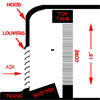 |
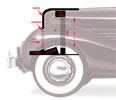 |
|
| Annotated geometry v14. Imagine having x-ray vision and looking at the Cord's coffin nose from the side. | ||
An essential feature of Flow Illustrator is the ability for the user to specify a custom geometry via a bitmap image file. Lynn goes to his garage and makes measurements of Ginger (his 812 S/C Custom Beverly). He creates fourteen versions of the bitmap geometry file (using Adobe Photoshop) before he is relatively satisfied with the result. Larger bitmaps would likely make for a better simulation, but will also result in much longer run times. In the end, Lynn settles on a 512x512 bitmap to specify the geometry.
Besides the geometry file, the user needs to select one important physical parameter, Re, the effective Reynolds number. The Reynolds number is a dimensionless value used in fluid dynamics problems. It expresses the relative importance of inertia ("a body in motion tends to stay in motion..") to viscosity (friction). For air moving past automotive bodies, a Reynolds number of several million would be typical. The detailed information on Flow Illustrator site explains why the default value of 1000 might be a more reasonable value for the effective Reynolds number needed for their solution of the Navier-Stokes equation. After experimenting with Re values of 10-1,000,000, Lynn eventually settles on using a value of 5,000 for his simulations.
A couple of computational parameters need to be specified. The default value is 0.01 for the simulation timestep, dt (delta t). Smaller timesteps will (to a point) improve results, but also causes longer run times. Lynn settles on 0.005 as the timestep for his simulations.
Finally the user can specify the duration of the simulation which has a default value of 10. It takes some time for the simulation to reach something approaching a steady state. Lynn uses 20 as the default for his simulations.
The output from Flow Illustrator is an AVI (Audio Video Interleave) movie file. For the parameters used here, the resulting file takes about 5-10 minutes to be generated and is about 13 MB in size. Lynn plays the file on his PC using Winamp, grabs frames using Alt-PrintScreen, and edits the images in Adobe Photoshop.
Some results for the Custom Cord radiator
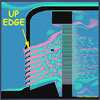 |
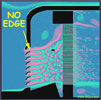 |
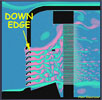 |
|
| There are noticeable effects from changing the louver trailing edge: edge up (left); no edge (center); edge down (right). | |||
In spite of his warning about the validity of the simulations, Lynn nevertheless tries to learn something about the airflow across the Cord radiator. His first result is that he does not replicate Josh's butterfly experiment. As far as the simulated results are concerned, the louvers on the Custom Cord seem to do a reasonable job of directing the airflow toward the middle of the radiator core. (Lynn also does some simulations with one less louver, as in a standard 810/812, without significant changes in the result.)
What should we make of this result? Nothing conclusive.
Of course, one can immediately question the validity of this simple, two-dimensional simulation. Further, the physical evidence with which we are comparing was from a poorly controlled experiment—maybe the butterflies only entered through the top louver.
One thing that Lynn has observed from his days as a scientist is that results from simple models, if inaccurate when considered directly, are sometimes helpful in exploring trends or variations. That is, differences between results can be more accurate than the results themselves. (As an analogy, one can imagine a thermometer that systematically gives the wrong temperature, but accurately measures changes in temperature.)
As an example, Jim Lawrence mentioned his concern about the upward bend (stiffener) on the trailing edge of the Cord hood louvers. He felt that they would tend to push the air upward. To explore this idea, Lynn runs three simulations with different treatments of the louver trailing edge: one with the upward bend (like that on the stock louver); one with no bend; one with a downward bend. Results for these three cases are shown above. Indeed, the louvers with the upward bend do push the simulated airflow up by one or two inches compared with the other cases. On the other hand, the airflow isn't drastically altered so it's unclear how important this effect really is.
What's next?
 |
|
| Considering only two-dimensional airflows, what about the flow around the sides of the hood and fenders? | |
There may not be too much more that can be learned from use of the Flow Illustrator website to explore this issue. What should be done on the simulation side is a three-dimensional simulation using more accurate geometry, something that is currently beyond Lynn's capabilities. On the experimental side, Josh mentioned an idea of planting a small video camera under a Cord hood and performing more controlled experiments.
One thing that might be explored with Flow Illustrator is two-dimensional flow in the horizontal plane as suggested by the overhead view of a Cord, above. Maybe something can be learned from looking at the flow between the fenders and hood. For example, one might expect this air to be moving fast (which implies low pressure by Bernoulli's principle) perhaps diverting airflow from the radiator.
In any case, Lynn has thoroughly enjoyed a few days of exercising his grey cells and thanks Josh Malks for the stimulating idea. Lynn also wishes to thank Sergei Chernyshenko for creating the marvelous Flow Illustrator website.
![]()
Contact  with your comments or questions
with your comments or questions
Copyright © 2018 Lynn Kissel
Last updated: Dec. 2, 2011